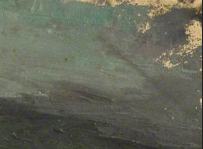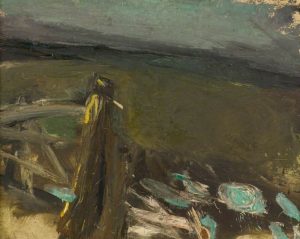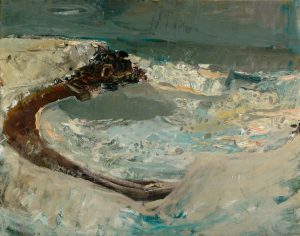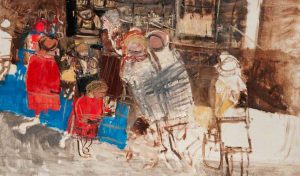Living Between Places by Amy Turnbull
The grand spectacle of a sweeping external stone stair adorns the outside of the McManus galleries. Its aging sandstone watches over me as I move towards it, only to be guided to the side entrance. At first, the McManus appears as another conventional art gallery, but now something more seems to be lurking inside. Modern meets historical here in the contrast of wide, glass doors and the building’s Gothic revival style. The dates of art pieces I encounter run into each other, blurred, in the back of my mind. A suit of armour stands meters away from a metal enclosed staircase. White walls divide different periods of art. A tower of coloured glass bottles decorates the entrance to the Victorian gallery. Art has no rules here; there are simply reactions. I find the exhibition I have come to see. It is titled As we see it. These words pull my emotions to the surface, heart in hand, stripping away any remaining preconceived notions I had left of this place.
It is here I find ‘her’, a small painting hidden in a corner of the gallery. Her name is The Stile and she is one of the many creations of Joan Eardley. Dressed in dreary colours and uneven brushstrokes, she appears as a window into a landscape beyond. The hills can only be seen by the eyes of a familiar onlooker. Oil paints collect at her corners, creating a field overrun by moss―thick moss―that a pair of wellies might get stuck in. Squelching sounds might be heard, muddy puddles might have drowned her sky in grey. The sun has not touched her for days; there is only the smell of wet grass. Greens and greys mix together as one colour. A crooked fence post appears in one corner, a gate opening into the field beyond. The fall of the fence matches the slope of the grass as if a wind had blown through the painting and swept up everything in its path. Great weather for farmers, but, perhaps not for country walks. The stile itself appears in a vivid blue, contrasting this weather-washed scene. It is clear that even in this dreary country day there is still, within the painting, something with warmth at its core. Eardley’s simple selection of colour brings a whole new set of ideas.
Jericho Parms speaks of how colour and shades are significant in conveying metaphors and feelings;
a chapter that contains the story of a single human experience, a retrospective of memory, the folded edges of paper, and pleasure and pain, which exist in the heart’s chamber, like a studio, like a cabinet of curiosity. The heart contains us.
We search for meaning in the choice of material painted on, the way a brush is moved across the canvas, the choice and blend of colour; even the slight addition of yellow within a green might change the painting’s meaning. How does colour possess a person so much as if to understand that it is more than just the weather? How can art give another life, another world to be explored? We are but a guest in its presence, waiting to be swept up in the story.
Growing up in the countryside, the story that The Stile tells resonates with me. There is something about country life that I hate. In my memories, it is always flooded in rain, the river Nith constantly overflowing in the town centre, taking everything with it. The beauty of the coast may be praised for its peaceful nature and scenic views, but what is the point of such loveliness when you cannot enjoy it? Trudging through mud filled fields, getting covered in ticks, and hearing a farmer’s curse from the distance is commonplace for anyone living in the country. The city, on the other hand, is a place of anonymity; you don’t know anyone’s story, and no one knows yours. To me, this seems a kind of utopia. In the country, you couldn’t walk somewhere, talk to someone, even breathe without the whole town knowing. Someone would find a way to twist a drunken blathering into life-altering drama and gossip.
In my mind, country life is present in those dull green tones that Eardley soaks her canvas in. Dull people following their dull lives in their dull town, nothing new ever happening beyond sheep or idle chat. Yet that the blue of The Stile sticks in my mind. Rare summer days in an open field with my friends, a light breeze teasing the back of my neck or whistling through my hair, and the family dog running beyond us with the brightest grin on her face. Eardley’s blue evokes memories of the fisherman’s lodge, running into the river with my dad, tossing pebbles, and climbing the riverbanks to dive in. On the rare chances I got to go fishing, or when I caught a trout for the first time only to set it free, such memories turn into some of those uncommon picturesque reminiscences that you might read of in books. For a moment, the pleasures of the city are dampened by the laugh of nostalgic memories. Yet, those days are what I struggle to hold now as I move further and further from that place I call home.
I wish I could find a pair of those rose-tinted glasses to swoon over the memories, but the town I lived in was still stuck in the 18th century. I would try to put my point across, a new opinion from a younger generation but I was constantly put down as too young to know.
We must grow up and see our surroundings as they are. Eardley herself moved to the countryside from the city, from Glasgow to Catterline. She had been visiting the small fishing village with her friend before deciding to move there. Previously she had been known for painting tenement children of Glasgow. She had a taste for painting with honesty and not hide the truth under a sentimentalised veil. However, once she moved to Catterline she found a new muse: rural life. Eardley was attracted by wild seas and the expressiveness of nature. She would even go as far as to paint outside in storms in order to truly capture it. Her move to the countryside gave her the isolation she needed to focus on her art. Robert Gray, pictures her at the heart of this scene,
The storms here
are an opened furnace door
of wind and snow. She stood in the sea,
the water ahead
higher than her painting board.
Eardley was always finding something new to paint in these surroundings. Her palette was limitless. Eardley herself says she did not know what she was painting for but, rather, she simply enjoyed painting. However, her creations were more than simply another painting in a gallery. As Lachlan Goudie suggests, the pieces she created during her stay in Catterline are some of her most personal images. In fact, it was at Catterline that her ashes were scattered once she passed away, not Glasgow, not Sussex where she was born, but on that Kincardineshire beach she adored so much.
Joan Eardley struggled with depression during her life. She was known for being quiet and keeping to herself. In a short documentary on her life in Catterline, Ron Stephen, a resident of Catterline since 1945, said that Eardley may have felt the pressure from the fishing community with being an artist to get a ‘proper job’. Catterline was a small village with a tightknit work ethic. Perhaps this began to twist the view of her beloved countryside and why we see The Stile as a gloomier portrayal of her beloved Catterline.
In this sense, I relate to Eardley. She appears as someone who liked to keep to herself. She simply wanted to focus on what she loved. I believe that she turned to the country for that needed isolation but still found those pesky on-lookers. . . those who appear to be interested in every part of your life without even knowing you. But she neither hated the country nor the city. It is why her she painted both urban and rural life with great heart.
As someone who lived in a similar place, The Stile reeks of those cloudy skies that fill my every day. Yet Eardley seems to be still holding onto that childlike first love within the choice of blue. Something brought her there and also drove her away; that ambivalence, the pull and the push characterise, as Mark Doty writes, great art, ‘art that defies limit, that reaches a scale beyond human.’
*
When I first moved to the city, I wasn’t nervous. I didn’t feel out of my comfort zone. The fact I could walk five minutes and be in a city centre was a blessing I never knew I could have. When I returned home for the first time it was because I had to get braces fitted – it wasn’t that I missed home, but that I had to go. I couldn’t wait to get back to the city as soon as my feet hit that overgrown grass. I still felt in the loop of new experiences that excited me. Yet, again, there is that pang of something missing. I am still incomplete, still not completely at one my surroundings.
 The Stile is unfinished. In the top right corner, remainders of a blank canvas peek through. That emptiness, that loneliness echoes throughout the gallery as I stand before the painting. You are drawn to this unpainted nothingness. However, this piece is already framed. With Eardley gone, we shall never know what else she might have done. Nevertheless, there is something about that blank space that adds to the scene. It suggests that the countryside isn’t what it seems, that the grim and grey realities of life lurk within. The blankness could also gesture towards the fog of the city in the distance, showing that Eardley’s connection urban spaces was still as strong as ever. Lawrence Weschler writes that what is missing from paintings is just an important; it is the background noise that tells us ‘what those paintings are all about.’ This is similar to literature in the way that a metaphor can hold as many secrets as a brush stroke— that the two are completely separate mediums but connected in their unlocking of deeper meanings. The fact that The Stile is literally missing information hinges on answering ‘why’, waiting on ‘a word…to be spoken’.
The Stile is unfinished. In the top right corner, remainders of a blank canvas peek through. That emptiness, that loneliness echoes throughout the gallery as I stand before the painting. You are drawn to this unpainted nothingness. However, this piece is already framed. With Eardley gone, we shall never know what else she might have done. Nevertheless, there is something about that blank space that adds to the scene. It suggests that the countryside isn’t what it seems, that the grim and grey realities of life lurk within. The blankness could also gesture towards the fog of the city in the distance, showing that Eardley’s connection urban spaces was still as strong as ever. Lawrence Weschler writes that what is missing from paintings is just an important; it is the background noise that tells us ‘what those paintings are all about.’ This is similar to literature in the way that a metaphor can hold as many secrets as a brush stroke— that the two are completely separate mediums but connected in their unlocking of deeper meanings. The fact that The Stile is literally missing information hinges on answering ‘why’, waiting on ‘a word…to be spoken’.
So, when it comes to the city and country life why are we so divided? Why is it as soon as rural children graduate, they all rush to the city? My own understanding is put into question. Despite my clear distaste for my hometown, I do still return there. I do still have connections there. Maybe I still hope that it might change. I know I don’t want to live in one place forever, but do not know if it is to be a rural life or my town specifically? I have only lived in the city for three years now, but I adore it. Even though Eardley moved from the city to the country, and I the country to the city, there this sense of yearning for a middle ground to meet at.
On the other hand, it is maybe more a question of growth than a question of where to live. When Eardley was diagnosed with cancer in 1963, she was told she was too unwell to paint outside. She tried to turn to still life painting and those children she grew fond of in Glasgow. Yet, this still wasn’t enough for her. She wrote in a letter to her friend, ‘this genteel subject matter was not her ideal preference.’ Her own body limited her doing what she loved, and she was forced to return to what she had once known. This makes me ask if I will always be comfortable in the city or if I too will be forced to return to that town. Eardley tried to follow her path as she pleased and was a successful artist, but at a cost of dying young. Nevertheless, if we live our lives to the fullest, whether we die young or old should not matter. As long as we have celebrated the life we have lived, no matter if it is in the city or the country, then surely it is worth the living. Joan Eardley’s life was about the journey she took, the art she created, and the messages she left behind. For now, I shall continue to live in this odd labyrinth I have grown to know and I too will learn from the world surrounding me; ‘The world breaks everyone and afterwards many are strong at the broken places.’
Have I read too much into The Stile or has Eardley read me too well? Doty comments on this vital connection we have with art: ‘we long to connect; we fear that if we do; our freedom and individuality will disappear.’ We are but a guest in its presence, waiting to be swept up in the story.
© Amy Turnbull
Notes
- ‘a chapter that contains the story. . . heart contains us’: Jericho Parms’ ‘A Chapter on Red’ in Hotel Amerika. ([n.p]: Spring 2013); p. 19.
- ‘The storms here. . . painting board’: Robert Gray’s ‘Joan Eardley in Catterline’ in Michigan Quarterly Review. (Michigan: University of Michigan. Summer 2012). Vol. 51.3; p. 378.
- ‘proper job’: Becky Manson. The Story of Scottish Art: Joan Eardley.National Galleries Scotland. October 28th, 2015. <https://www.nationalgalleries.org/art-and-artists/features/story-scottish-art-joan-eardley> [09.12.19].
- ‘art that defies limit, that reaches a scale beyond human’: Mark Doty, ‘ The Lessons of Objects: An Interview with Mark Doty by Andrew David King’, Kenyon Review, December 12, 2012. <https://kenyonreview.org/2012/12/mark-doty-interview/>
- ‘what those paintings are all about’: Lawrence Weschler. Vermeer in Bosnia. (United States: Vintage Books. July 2005); p. 16.
- ‘a word…to be spoken’: Mark Doty. Still Life with Oysters and Lemons. (Boston: Beacon Press. 2002); p. 19
- ‘this genteel subject matter was not her ideal preference’: National Galleries.Joan Eardley <https://www.nationalgalleries.org/art-and-artists/features/joan-eardley> [09.12.19].
- ‘The world breaks everyone and afterwards many are strong at the broken places’: Ernest Hemingway. A Farwell to Arms. ([n.p]: Everyman. 1993).
- ‘we long to connect; we fear that if we do; our freedom and individuality will disappear’: Mark Doty, ‘ The Lessons of Objects: An Interview with Mark Doty’, Kenyon Review, December 12, 2012.
Bibliography:
Ernest Hemingway. A Farwell to Arms. ([n.p]: Everyman. 1993).
Jericho Parms’ ‘A Chapter on Red’ in Hotel Amerika. ([n.p]: Spring 2013).
Lawrence Weschler. Vermeer in Bosnia.(United States: Vintage Books. July 2005).
Mark Doty. Still Life with Oysters and Lemons. (Boston: Beacon Press. 2002).
Robert Gray’s ‘Joan Eardley in Catterline’ in Michigan Quarterly Review. (Michigan: University of Michigan. Summer 2012). Vol. 51.3.
Mark Doty’ The Lessons of Objects: An Interview with Mark Doty by Andrew David King’, Kenyon Review, December 12, 2012 <https://kenyonreview.org/2012/12/mark-doty-interview/> [09.12.19].
Becky Manson. The Story of Scottish Art: Joan Eardley. National Galleries Scotland. October 28th, 2015. <https://www.nationalgalleries.org/art-and-artists/features/story-scottish-art-joan-eardley> [09.12.19]
National Galleries. Joan Eardley: A Sense of Place. YouTube. December 1st, 2016. <https://www.youtube.com/watch?v=lekhdsXD-Ro&feature=emb_title> [09.12.19]National Galleries Scotland. Joan Eardley. National Galleries Scotland. <https://www.nationalgalleries.org/art-and-artists/features/joan-eardley> [09.12.19]Rosie Spinks. Cities are built with language: how poetry feeds on urban life. The Guardian. 6 October 2016. <https://www.theguardian.com/cities/2016/oct/06/cities-poetry-urban-language-national-poetry-day> [28.10.19]
[Ed – Amy Turnbull is a year 3 English and Creative Writing Student. This was part of her end of semester Creative Essay submission.]




Thought provoking. City or Town? As you age, the draw of the city will leave you craving the peace and tranquility of the closeness to the countryside that a small town can offer. A wonderful and worthwhile read. Thank you.
Having came from the City and the tenements of Glasgow . I can’t help but wonder if Eardley was fleeing from herself or the actual City. The Glasgow tenements were dreary and dull; the colour grey was prominent wherever you looked . Perhaps Eardley was looking for colour and soon began to realise through that no matter where she was, her journey and art would be shadowed by the darkness of her illness .
Thank- you for introducing me to this thought provoking piece of writing .